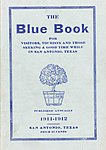Alamo Colleges District
1945 establishments in TexasAlamo Colleges DistrictSchool districts established in 1945Two-year colleges in Texas
The Alamo Colleges District (previously the Alamo Community College District, or ACCD, and The Alamo Colleges) is a network of five community colleges in San Antonio and Universal City, Texas, and serving the Greater San Antonio metropolitan area. The district was founded in 1945 as the San Antonio Union Junior College District before adopting the Alamo name in 1982.
Excerpt from the Wikipedia article Alamo Colleges District (License: CC BY-SA 3.0, Authors).Alamo Colleges District
North Pecos-La Trinidad, San Antonio
Geographical coordinates (GPS) Address Nearby Places Show on map
Geographical coordinates (GPS)
| Latitude | Longitude |
|---|---|
| N 29.4271 ° | E -98.502480555556 ° |
Address
Motel 6
North Pecos-La Trinidad 211
78207 San Antonio
Texas, United States
Open on Google Maps










